Google Analytics vs Pardot
November 12, 2023 | Author: Sandeep Sharma
40
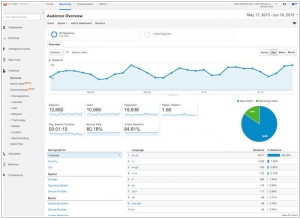
Google Analytics lets you measure your advertising ROI as well as track your Flash, video, and social networking sites and applications. Google Analytics shows you the full customer picture across ads and videos, websites and social tools, tablets and smartphones. That makes it easier to serve your current customers and win new ones.
4
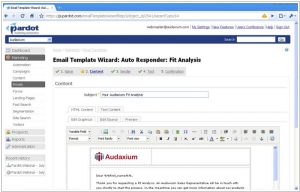
Pardot offers a software-as-a-service marketing automation application that allows marketing and sales departments to create, deploy, and manage online marketing campaigns that increase revenue and maximize efficiency. Pardot features certified CRM integrations with salesforce.com, NetSuite, Microsoft Dynamics CRM, and SugarCRM, empowering marketers with lead nurturing, lead scoring, and ROI reporting to generate and qualify sales leads, shorten sales cycles, and demonstrate marketing accountability.
Google Analytics and Pardot are two distinct platforms that serve different purposes in the realm of digital marketing and analytics. Google Analytics is a powerful web analytics tool that focuses on tracking website traffic, user behavior, and conversion rates. It provides detailed insights into user demographics, traffic sources, and behavior patterns to help businesses optimize their online presence. Google Analytics is widely used and offers a user-friendly interface, extensive integration options, and robust reporting capabilities. On the other hand, Pardot is a marketing automation platform that focuses on lead generation, nurturing, and management. It provides tools for email marketing, lead scoring, campaign tracking, and CRM integration. Pardot enables businesses to streamline their marketing efforts, track customer interactions, and automate marketing workflows.
See also: Top 10 Web Analytics software
See also: Top 10 Web Analytics software
Google Analytics vs Pardot in our news:
2020. Google Analytics 4 allows to combine website and mobile app statistics
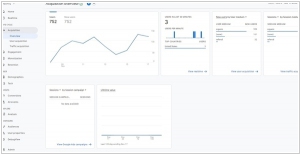
Google has introduced a major update to its website analytics platform, Google Analytics 4. The key highlight of this update is the inclusion of a new resource type called App + Web. This feature allows users to combine data from both websites and mobile applications, enabling the creation of unified reports for comprehensive analysis. The functionality of analytics tools has been significantly revamped, with improved visualization of user behavior and the adoption of a new model called "Event + Parameter." Notably, the updated platform now offers enhanced capabilities for online stores. Users can create user groups based on the likelihood of placing an order or leaving the website within the next seven days. It is important to note that the option to continue using the previous version, Universal Analytics (UA), is still available. Users have the flexibility to work with both Universal Analytics and Google Analytics 4 simultaneously by creating new resources with dual analytics capabilities (UA + GA4). This dual approach is designed to accommodate users who may find exclusive use of the new tool less convenient in certain scenarios.
2016. Google Analytics adds automated insights
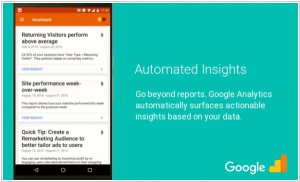
Google Analytics has introduced enhanced functionality on iOS and Android platforms, allowing users to easily identify crucial trends within their data. On the Assistant screen, users will now have access to automatically generated insights. For instance, if there is a sudden surge in new users on your website or app, Google Analytics will prominently highlight this information and provide details regarding the source of these new users. Likewise, for e-commerce companies, it can pinpoint the products experiencing the most significant increase in sales. Although Google Analytics was already tracking this information, it is now presented in a concise and easily digestible card format. This enhancement enables businesses to swiftly access the relevant information without the need to navigate through multiple pages, reducing the chances of overlooking important data changes.
2016. New Google Analytics app improves user experience
The most recent update of the Google Analytics app (version 3.0) introduces several features inspired by chat platforms. Google has streamlined the app's navigation, resulting in a cleaner interface that enhances the visibility of reports. Metrics and dimensions are now displayed within scorecards, which bear a resemblance to the widgets found in Google Analytics dashboards. These scorecards present a concise overview of the top dimensions within a specific report. By utilizing familiar tablet and smartphone user behaviors, such as swiping, users can easily navigate to their desired dimensions. The condensed listing of scorecards also facilitates the effortless discovery and bookmarking of reports.
2015. Google Analytics adds Calculated Metrics
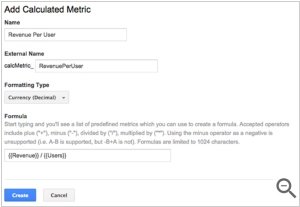
Google has introduced a new feature in Google Analytics called Calculated Metrics. This feature enables users to create custom metrics based on existing metrics within Google Analytics. It eliminates the need to navigate away from the report, streamlining the process of performing calculations. Essentially, Calculated Metrics serves as a convenient tool for adding compound metrics that frequently arise in business intelligence discussions. For instance, an e-commerce retailer could generate a currency conversion metric by multiplying the Revenue metric from Google Analytics reports with the current conversion rate. To access Calculated Metrics, users can find it in the admin panel under the view column.
2015. Marketing software Pardot improves collaboration and productivity
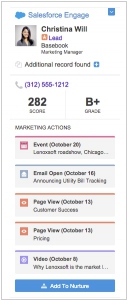
B2B marketing automation software Pardot (owned by Salesforce) has recently introduced a range of beneficial enhancements for productivity and collaboration. These include a Chrome extension that enables email tracking, faster data synchronization, improved data visualization, and enhanced customization options for reporting. The Chrome extension for Gmail is an invaluable marketing automation plug-in that empowers sales representatives to send trackable emails directly from their Gmail accounts. It not only simplifies their tasks, allowing them to sell more effectively, but also serves as a covert B2B tool disguised as a harmless email plug-in. The additional improvements offer similar advantages. Notably, the data synchronization with Salesforce now boasts the fastest speed among all marketing automation tools, as it checks for changes every two minutes. This convenience benefits sales representatives by promptly revealing prospect insights, enabling them to respond swiftly and gain a competitive edge.
2014. Salesforce announced Sales Reach to promote Pardot
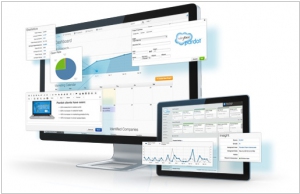
The primary source of revenue for Salesforce comes from subscriptions to the Sales Cloud. However, the company is also focused on expanding its earnings in the marketing solutions sector. To this end, Salesforce made a significant investment of up to $2.5 billion last summer to acquire ExactTarget/Pardot, a marketing-automation and campaign-management software. Yesterday, Salesforce announced a new feature for its Sales Cloud called Sales Reach. This optional feature brings the fundamental capabilities of Salesforce.com's marketing-oriented Pardot offering to salespeople. Sales Reach empowers salespeople to create micro campaigns, track responses to those campaigns, and receive real-time notifications when prospects engage with campaign content, such as downloading materials, attending events, or viewing videos. Additionally, salespeople can invite prospects to join communities, and they can perform all of these actions through their Salesforce1 mobile apps. Sales Reach is set to be available in the first half of 2015.
2014. Google Analytics is available on iPhone
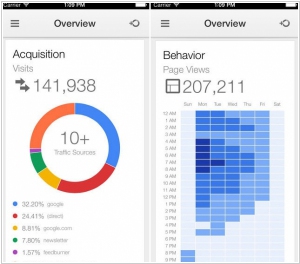
After more than two years of launching Google Analytics for Android, Google has now introduced a version of Google Analytics specifically designed for the iPhone. This app enables users to conveniently monitor their website analytics, including real-time visitor reports, directly from their smartphones. In addition to providing real-time and time-based reports, the app offers insights into user behaviors, conversions, and more. The user interface (UI) of the app aligns with the aesthetic of other Google apps available for iOS. Moreover, the app leverages the sign-in capabilities of Gmail, Google+, and the standard Google app for iOS. It's important to note that Google Analytics for iPhone is currently not optimized for iPad, but there is hope that future updates will include support for iPads.
2014. Google Analytics gets brand new E-Commerce section
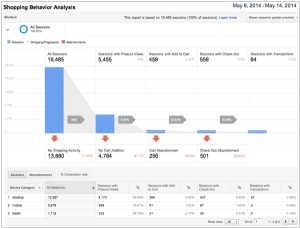
Google is introducing a comprehensive overhaul of its Google Analytics E-commerce, focusing on delivering insights throughout the entire customer journey, going beyond just the purchase stage. The updated version includes new metrics such as product detail views, 'add to cart' actions, clicks on internal campaigns, the effectiveness of internal merchandising tools, the checkout process, and the final purchase. Additionally, users can now create audience segments directly from funnel reports to analyze user actions, including cart and product page abandons. Funnels are accessible at the device category level, as depicted in the screenshot below.



